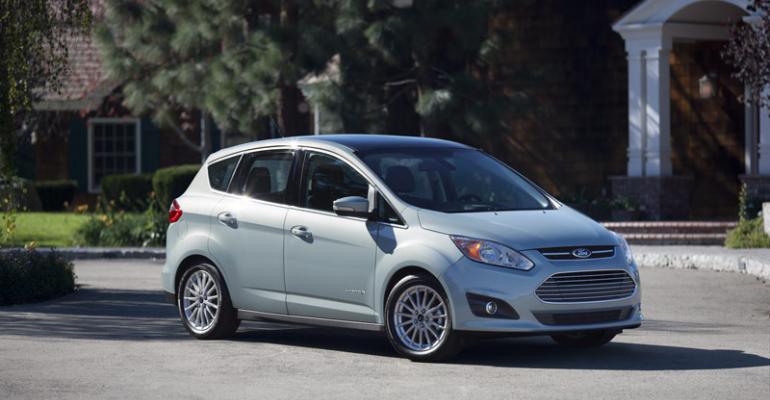WAYNE, MI – Ford says sharing components among its electrified vehicle lineup is allowing it to shave 30% off development costs and improve production efficiency.
“This is not only how we maximize product for the customers but (also) how we maximize efficiency in terms of our overall execution,” John Davis, chief program engineer for C-cars, says at a media event at Ford’s C-Max and Focus assembly plant here.
Ford’s current portfolio of electrified vehicles, which includes the C-Max hybrid and plug-in hybrid, Fusion hybrid and plug-in, Lincoln MKZ hybrid and Focus battery electric vehicle, share a number of components, including but not limited to electric water pumps and heaters, transaxle oil pumps and regenerative brakes.
A new hybrid gearbox, assembled at Ford’s Van Dyke transmission plant in Sterling Heights, MI, also is common to the electrified vehicles, with the exception of the Focus BEV, and all share the same engines.
The auto maker also is working with just two platforms: The Fusion and Lincoln hybrids are based on Ford’s global C/D-car architecture, while the Focus BEV and C-Max use the global C-car platform. “The C-Max is very much a part of the Focus family,” Davis says.
Sharing components among all Ford’s vehicles is a long-term strategy that is gaining momentum. Davis says about 60% of C-Max parts are shared in models sold in North America and Europe, while commonality in the Focus is 80%.
“Part of the difference in (the) C-Max is we’re introducing the hybrid powertrain here, which we haven’t done in Europe,” Davis says. “So from that standpoint, it’s going to drive some of the (parts) differentiation.”
Ford sells gasoline- and diesel-powered versions of the C-Max in Europe and will introduce the low-volume PHEV version there in the future. There are no plans to offer the C-Max hybrid in Europe.
Ford would like to see 100% parts commonality in its global lineup, but reaching that goal may not be possible because of differing government regulations, says Davis, noting regional consumer preferences also play a role in restricting parts-sharing.
For example, “In Europe, we offer a lock/unlock switch on the center console, but in North America customers expect the switch to be on the doors,” he says. “So it’s a matter of ‘can we satisfy the customer with a common design, or not?’ And in the cases where we can’t, we have decided to customize that product for the region.”
Another advantage of parts-sharing is that it leads to higher quality levels, because components don’t have to be engineered more than once, thus eliminating the chance of flaws, Davis says.
Ford would like to commonize other parts of the vehicle, including the interior. The ’13 Escape cross/utility vehicle, for instance, shares most of its interior features, such as the seats and instrument panel, with the C-Max.
Davis says sharing interior parts does not affect a vehicle’s individuality as long as the practice does not detract from the consumer experience. “It’s certainly more efficient to leverage a common design, assuming it satisfies customers across regions.”
Even with interiors, government regulations can get in the way. Take the pillar-less sliding doors on the Ford B-Max CUV, currently sold only in Europe. The edges of the doors meet when closed to replicate a B-pillar, but Davis says trying to migrate that design to North America would be difficult because of strict second-row impact requirements here.
“So that’s a big difference,” he says. “It would be very tough to deliver here.”
However, Ford is looking at similar door designs for North American products, Davis says, without offering specifics. “I’m sure we’ll introduce a product like that in the future. But for now, it’s tough to make a one-size-fits-all (part) across all markets.”





